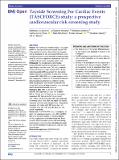Files in this item
Tayside Screening For Cardiac Events (TASCFORCE) study : a prospective cardiovascular risk screening study
Item metadata
| dc.contributor.author | Lambert, Matthew A | |
| dc.contributor.author | Houston, J Graeme | |
| dc.contributor.author | Littleford, Roberta | |
| dc.contributor.author | Fitton, Catherine A | |
| dc.contributor.author | Struthers, Allan | |
| dc.contributor.author | Sullivan, Frank | |
| dc.contributor.author | Gandy, Stephen | |
| dc.contributor.author | Belch, Jill J F | |
| dc.date.accessioned | 2022-11-09T13:30:29Z | |
| dc.date.available | 2022-11-09T13:30:29Z | |
| dc.date.issued | 2022-10-21 | |
| dc.identifier | 281841433 | |
| dc.identifier | 15b6fc45-d226-439b-8e4a-d165b25995e1 | |
| dc.identifier | 36270757 | |
| dc.identifier | 85140352052 | |
| dc.identifier | 000879360200005 | |
| dc.identifier.citation | Lambert , M A , Houston , J G , Littleford , R , Fitton , C A , Struthers , A , Sullivan , F , Gandy , S & Belch , J J F 2022 , ' Tayside Screening For Cardiac Events (TASCFORCE) study : a prospective cardiovascular risk screening study ' , BMJ Open , vol. 12 , no. 10 , e063594 . https://doi.org/10.1136/bmjopen-2022-063594 | en |
| dc.identifier.issn | 2044-6055 | |
| dc.identifier.other | ORCID: /0000-0002-6623-4964/work/121754302 | |
| dc.identifier.uri | https://hdl.handle.net/10023/26345 | |
| dc.description | Funding: This study was funded by Chest Heart and Stroke (Scotland) and the Souter Foundation. | en |
| dc.description.abstract | Purpose: Risk factor-based models struggle to accurately predict the development of cardiovascular disease (CVD) at the level of the individual. Ways of identifying people with low predicted risk who will develop CVD would allow stratified advice and support informed treatment decisions about the initiation or adjustment of preventive medication, and this is the aim of this prospective cohort study. Participants: The Tayside Screening for Cardiac Events (TASCFORCE) study recruited men and women aged≥40 years, free from known CVD, with a predicted 10-year risk of coronary heart disease<20%. If B-type natriuretic peptide (BNP) was greater than their gender median, participants were offered a whole-body contrast-enhanced MRI (WBCE-MRI) scan (cardiac imaging, whole-body angiography to determine left ventricular parameters, delayed gadolinium enhancement, atheroma burden). Blood, including DNA, was stored for future biomarker assays. Participants are being followed up using electronic record-linkage cardiovascular outcomes. Findings to date: 4423 (1740, 39.3% men) were recruited. Mean age was 52.3 years with a median BNP of 7.50 ng/L and 15.30 ng/L for men and women, respectively. 602 had a predicted 10-year risk of 10%-19.9%, with the remainder<10%. Age, female sex, ex-smoking status, lower heart rate, higher high-density lipoprotein and lower total cholesterol were independently associated with higher log10 BNP levels. Mean left ventricular mass was 129.2 g and 87.0 g in men and women, respectively. Future plans: The TASCFORCE study is investigating the ability of a screening programme, using BNP and WBCE-MRI, at the time of enrolment, to evaluate prediction of CVD in a population at low/intermediate risk. Blood stored for future biomarker analyses will allow testing/development of novel biomarkers. We believe this could be a new UK Framingham study allowing study for many years to come. Clinical Trial Registration: ISRCTN38976321. | |
| dc.format.extent | 8 | |
| dc.format.extent | 513983 | |
| dc.language.iso | eng | |
| dc.relation.ispartof | BMJ Open | en |
| dc.subject | RA0421 Public health. Hygiene. Preventive Medicine | en |
| dc.subject | E-DAS | en |
| dc.subject | SDG 3 - Good Health and Well-being | en |
| dc.subject | MCC | en |
| dc.subject.lcc | RA0421 | en |
| dc.title | Tayside Screening For Cardiac Events (TASCFORCE) study : a prospective cardiovascular risk screening study | en |
| dc.type | Journal article | en |
| dc.contributor.institution | University of St Andrews. School of Medicine | en |
| dc.contributor.institution | University of St Andrews. Sir James Mackenzie Institute for Early Diagnosis | en |
| dc.contributor.institution | University of St Andrews. Population and Behavioural Science Division | en |
| dc.identifier.doi | https://doi.org/10.1136/bmjopen-2022-063594 | |
| dc.description.status | Peer reviewed | en |
This item appears in the following Collection(s)
Items in the St Andrews Research Repository are protected by copyright, with all rights reserved, unless otherwise indicated.

